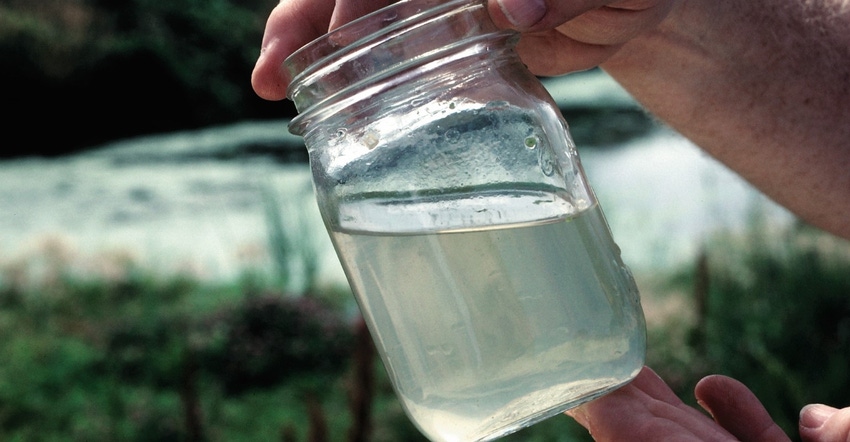
In a new policy memorandum on Accelerating Nutrient Pollution Reductions in the Nation’s Waters issued April 5, the Environmental Protection Agency commits to deepening existing partnerships and fostering new collaboratives with USDA, states, tribes, territories, agriculture, industry and the broader water sector. But the agency’s suggestions aren’t completely welcomed.
In the agency’s memo, EPA commits to supporting innovation and pursuing science-based and data-driven strategies to reduce excess nutrients in our nation’s waters, along with technical assistance and other support to help scale effective nutrient loss reduction strategies. Funding from the bipartisan infrastructure law will provide resources to accelerate these efforts, such as the work happening through the Gulf Hypoxia Taskforce on state nutrient reduction strategies.
“Nutrient pollution is one of America's most widespread, costly and challenging environmental problems,” says EPA Assistant Administrator for Water Radhika Fox. “Our nutrients memo is a call for scaling up the innovative approaches being used by farmers, ranchers, water agencies, local municipalities, industry and communities to make progress.”
The American Soybean Association appreciates that EPA plans to deepen its collaboration with agriculture in Washington, D.C. and on the ground, working to help USDA target funds to locations and practices that will best reduce nutrient loads and expanding engagements with ag stakeholders and highlighting their successes.
Under Secretary for Farm Production and Conservation Robert Bonnie says, “Through voluntary, incentive-based conservation programs, USDA helps agricultural producers improve the timing and application method of nutrients, which supports food and fiber production while also reducing the impacts on the environment.”
Soy farmers look forward to working with the agencies on voluntary, incentive-based strategies to build on years of success reducing nutrient loads in the nation’s waters. ASA also appreciates EPA focusing on all sources of nutrient pollution—not just the agriculture sector—as well as the agency’s focus on market-based approaches, including credit trading, to meet water quality goals.
Numeric nutrient criteria concerns
Courtney Briggs, American Farm Bureau Federation senior director of congressional relations, explains EPA’s memo offers good things and some “not so good things” on its approach to encourage change. EPA has had consistent dialogue with agriculture stakeholders in efforts to reduce nutrient pollution.
“We love that they recognize the role agriculture has played and really wants to deepen the collaborative relationship with agriculture,” Briggs says of the message seen front and center in the memo. However, some of the suggestions in reaching desired outcomes is troublesome.
“Agricultural communities in various states, particularly the Mississippi River Basin, have really stepped up to be proactive about nutrient loss strategies. But this is not something just agriculture can fix. I’m happy with the memo’s notion that we need to work collaboratively across various sectors to achieve our goal,” Briggs says.
The EPA memo is “urging more robust adoption of numeric nutrient criteria, particularly the newly published stressor-response based numeric criteria recommendations to address nutrient pollution in lakes and reservoirs, into Water Quality Standards.”
Briggs explains, “While we have a shared view of many of the goals, one of the memo’s concerning objectives calls for states to incorporate numeric nutrient criteria into water quality standards. That is of concern.”
In the stick-versus-carrot approach of voluntary versus mandatory, Briggs says the numeric nutrient standards are more of the stick approach that can often be expensive for states to implement and can result in “unattainable standards.”
Many states have implemented narrative criteria, adds Briggs. Many states implement narrative criteria that encourage farmers to adopt best management practices in order to prevent unfortunate water quality outcomes.
“All of our goals are the same,” Briggs says of a desire to have clean water. “How we are achieving those goals, like including numeric nutrient criteria, we don’t agree upon. But we’re active players in this space, and we want to help lead this collaborative work.”
Ed Thomas, The Fertilizer Institute vice president of government affairs, says the final EPA memo incorporates a lot of suggestions made by the fertilizer industry and allows a lot of flexibility, rather than strict criteria, to states on how to capture and encourage producers to adopt the 4Rs nutrient stewardship strategy – right nutrient source at the right rate at the right time in the right place.
Thomas says states are offered flexibility on how to encourage the capturing of nutrients rather than strict numeric nutrient criteria around developing their state footprint loss reduction plans.
“We see that as a real benefit just because you get a bigger bang for your buck for implementing these best management practices on the field that really tend to capture a lot more nutrients and keep them out of the waterways as opposed to some of these numeric nutrient criteria, which are really expensive to develop and the models are really difficult to get it right,” Thomas says.
The memo highlights that the Clean Water Act regulatory authorities are the foundation for nutrient pollution reductions. The definition of “waters of the U.S.” underscores those authorities. ASA continues to recommend that EPA should pause their Clean Water Act rulemaking while the Supreme Court reviews Sackett v. EPA and must ultimately issue a science-based rule that includes longstanding exemptions for agricultural practices and prior converted cropland, as well as well-defined provisions that give farmers clarity to manage their businesses from year to year.
About the Author(s)
You May Also Like






